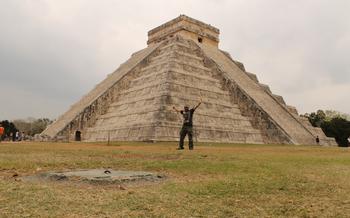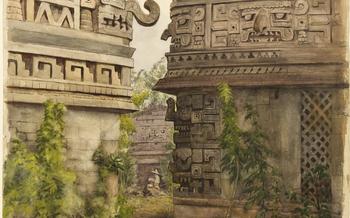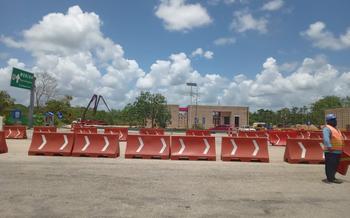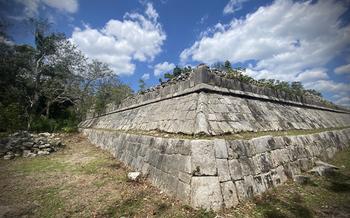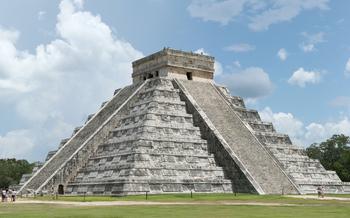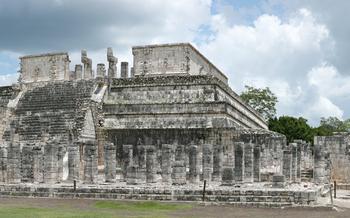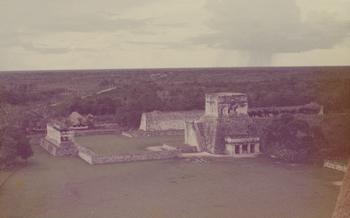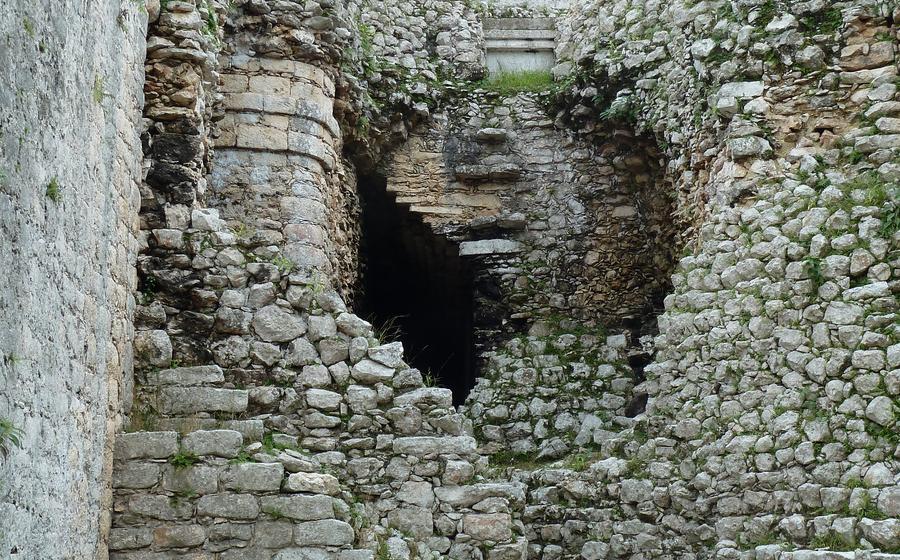
The Church
- Explore the Ancient Maya City of Chichen Itza
- El Castillo (Pyramid of Kukulcan): A Marvel of Mayan Architecture and Astronomy
- The Great Ball Court
- Temple of the Warriors
- Cenote Sagrado (Sacred Cenote)
- The Red House
- Las Monjas Complex: A Journey Through Sacred Spaces
- The Osario (Ossuary)
- Temple of the Initial Series
- The Market
- The Sound and Light Show: A Magical Journey Through Time
- Practical Information
- Getting There
- Where to Stay:
- Insider Tip:
Explore the Ancient Maya City of Chichen Itza
Journey back in time as you step into the ancient Maya city of Chichen Itza, a UNESCO World Heritage Site that stands as a testament to the ingenuity and grandeur of this enigmatic civilization. Delve into the fascinating history of the Maya, from their humble beginnings to their rise as one of the most advanced civilizations of the pre-Columbian Americas. Discover the unique architectural features of Chichen Itza, including the iconic El Castillo (Pyramid of Kukulcan), and marvel at the intricate carvings and sculptures that adorn the city's many structures. Immerse yourself in the rich cultural legacy of the Maya as you explore this awe-inspiring site, a symbol of their profound connection to the cosmos and their enduring impact on the world.
El Castillo (Pyramid of Kukulcan): A Marvel of Mayan Architecture and Astronomy
El Castillo, also known as the Pyramid of Kukulcan, stands as the centerpiece of Chichen Itza, a testament to the architectural prowess and astronomical knowledge of the ancient Maya. Towering over the city at a height of 24 meters, the pyramid's sheer size and intricate carvings are awe-inspiring.
Ascend the 91 steps leading to the summit and be rewarded with breathtaking views of the surrounding landscape, where the ancient city of Chichen Itza unfolds before your eyes. Marvel at the intricate carvings and sculptures adorning the pyramid's facade, depicting Mayan gods, mythical creatures, and scenes from everyday life.
Witness the famous "solstice effect" during the spring and autumn equinoxes, when the setting sun casts a serpent-like shadow down the pyramid's northern staircase. This phenomenon, known as the "descent of Kukulcan," is a testament to the Maya's advanced astronomical knowledge and their reverence for the feathered serpent god.
Explore the interior of the pyramid, where a narrow passage leads to a small chamber known as the Temple of the Jaguar. Here, discover the remains of a jaguar throne adorned with a mosaic mask of the jaguar god, a symbol of power and rulership in Mayan culture.
Delve deeper into the significance of El Castillo as a religious, political, and economic center. Learn about the Maya's belief that the pyramid was a sacred mountain, a conduit between the underworld and the heavens. Understand the pyramid's role as a temple for worship, a platform for astronomical observations, and a symbol of the Maya's power and prosperity.
The Great Ball Court
The Great Ball Court, or Juego de Pelota, is one of the most impressive and iconic structures at Chichen Itza. Measuring 168 meters long, 70 meters wide, and 15 meters high, it is the largest ball court ever discovered in Mesoamerica. The court is flanked by two massive sloping walls, each topped with a serpent-like balustrade. At the center of each wall is a stone ring, through which the ball was passed in the game.
The Great Ball Court was more than just a sports arena; it held deep symbolic and ritual significance in Maya culture. The game itself was believed to represent the struggle between the forces of light and darkness, with the ball representing the sun or the moon. The outcome of the game was seen as having important implications for the fate of the community.
In addition to its religious significance, the ball court was also a place of entertainment and spectacle. The games were often attended by large crowds of spectators who cheered on their favorite teams. The players were highly skilled athletes who trained extensively for the game. The game was played with a heavy rubber ball, and the players used only their hips and elbows to hit the ball. The rules of the game are not fully understood, but it is believed that the objective was to keep the ball in play as long as possible.
The Great Ball Court at Chichen Itza is a testament to the Maya's love of the game and its importance in their culture. It is a fascinating and impressive sight that should not be missed by any visitor to Chichen Itza.
Temple of the Warriors
The Temple of the Warriors is a must-see attraction within the ancient city of Chichen Itza. Towering over the surrounding structures, this temple offers breathtaking panoramic views of the archaeological site from its summit. Ascend the steep staircase to reach the top and be rewarded with a stunning vista that encompasses the Great Ball Court, the Pyramid of Kukulcan, and the surrounding jungle.
The temple's facade is adorned with intricate carvings and sculptures depicting fierce warriors and mythical creatures, showcasing the Maya's exceptional artistry and craftsmanship. These intricate details provide a glimpse into the Maya's beliefs and mythology, offering a tangible connection to their ancient worldview.
Originally constructed as a military and religious center, the Temple of the Warriors played a significant role in Maya society. It served as a place for conducting important ceremonies, rituals, and sacrifices. The temple's imposing presence and elaborate ornamentation reflect its importance as a symbol of power and authority within the Maya civilization.
Adjacent to the Temple of the Warriors lies the Group of the Thousand Columns, a vast complex of colonnades and platforms that once served as a residential and administrative area. Explore this fascinating complex to gain a deeper understanding of the Maya's daily life and social organization.
Cenote Sagrado (Sacred Cenote)
The Sacred Cenote, also known as the Cenote of Sacrifice, is a natural sinkhole located within the ancient Maya city of Chichen Itza. This cenote holds significant religious and cultural importance for the Maya people.
A Gateway to the Underworld
The Maya believed that cenotes were gateways to the underworld, Xibalba. They considered the Sacred Cenote to be a particularly sacred site, as it was believed to be a direct portal to the realm of the gods. Maya rulers and priests would often perform religious ceremonies and rituals at the cenote, seeking guidance and favor from the divine.
Offerings and Human Sacrifice
The Sacred Cenote was also a site for offerings and human sacrifice. The Maya believed that by offering precious objects and even human lives to the gods, they could ensure good harvests, favorable weather, and protection from harm. Archaeological excavations have revealed a wealth of artifacts, including gold, jade, and ceramic objects, as well as human remains, at the bottom of the cenote.
A Place of Beauty and Mystery
Today, the Sacred Cenote remains a place of great beauty and mystery. Visitors can marvel at the crystal-clear water, lush vegetation, and impressive rock formations that surround the cenote. While swimming is no longer permitted due to conservation efforts, visitors can still admire the cenote from a viewing platform or take a guided tour to learn more about its fascinating history and significance.
The Red House
Among the numerous structures at Chichen Itza, the Red House stands out with its vibrant red exterior. This distinctive color, derived from a natural pigment used by the Maya, gives the building its name. Once a residential complex occupied by high-ranking Maya officials and priests, the Red House offers a glimpse into the daily life of the Maya elite.
As you explore the various rooms and chambers within the complex, you'll encounter living quarters, kitchens, and workshops. The intricate carvings and decorations adorning the walls provide clues about the occupants' status and their role in Maya society. Imagine the bustling activity that once filled these spaces, as Maya nobles conducted their daily affairs and participated in important ceremonies.
The Red House is a testament to the Maya's advanced architectural skills and their attention to detail. The building's sturdy construction and well-preserved condition showcase the Maya's mastery of engineering and their ability to create structures that have withstood the test of time.
As you wander through the Red House, let your imagination transport you back to the days when Maya rulers and priests walked these halls, shaping the destiny of one of the most remarkable civilizations in history.
Las Monjas Complex: A Journey Through Sacred Spaces
Las Monjas Complex, located within the sprawling ruins of Chichen Itza, is a series of interconnected buildings and courtyards that served as a religious and administrative center, as well as a residence for high-ranking Maya women. Its name, meaning "The Nuns' Complex," is a misnomer given by early Spanish explorers who mistakenly believed that the complex was inhabited by nuns.
As you wander through Las Monjas, you'll be captivated by the intricate carvings and decorations that adorn the buildings' facades. These carvings depict scenes from Maya mythology, daily life, and important historical events, offering a glimpse into the rich culture and beliefs of the ancient Maya.
One of the most striking features of Las Monjas is its unique architectural style. The complex is characterized by corbelled arches and vaulted ceilings, which are rare in Maya architecture. These architectural elements demonstrate the advanced engineering skills of the Maya and their ability to create complex and durable structures.
As you explore the various buildings within Las Monjas, you'll discover a variety of rooms and chambers, including living quarters, kitchens, workshops, and temples. Each space has its own unique purpose and story to tell, shedding light on the daily life and customs of the Maya elite who resided here.
The complex is also home to several cenotes, or natural sinkholes, which were considered sacred by the Maya. These cenotes were used for religious ceremonies, offerings, and even human sacrifice. The presence of cenotes within Las Monjas adds to its spiritual significance and reinforces its connection to the Maya underworld.
Exploring Las Monjas Complex is a journey through sacred spaces, where you can immerse yourself in the rich history and culture of the Maya civilization. Its intricate carvings, unique architecture, and spiritual significance make it a must-visit destination for anyone interested in ancient history and archaeology.
The Osario (Ossuary)
Explore the Osario, a small pyramid-shaped structure located near the Sacred Cenote. Discover its function as a burial site, containing the remains of numerous Maya individuals. Learn about the Maya's elaborate burial practices and their beliefs regarding the afterlife. Witness the impressive carvings and sculptures adorning the Osario's exterior, depicting skulls and crossbones.
The Osario stands as a testament to the Maya's intricate burial customs and their belief in the afterlife. Its well-preserved carvings and sculptures offer a glimpse into their spiritual world and their reverence for their ancestors. As you walk through the Osario, imagine the ceremonies and rituals that took place here, as the Maya sought to honor their deceased loved ones and ensure their safe passage to the next realm.
The Osario is a reminder of the Maya's deep connection to their ancestors and their belief in the continuity of life beyond death. It is a place where the living and the dead converged, and where the Maya paid homage to those who had passed on.
Temple of the Initial Series
The Temple of the Initial Series, located within the ancient Maya city of Chichen Itza, holds significant historical and cultural importance. Named after the hieroglyphic inscription found on its lintel, the temple played a crucial role in Maya astronomy and calendrical rituals.
The facade of the temple features well-preserved carvings depicting a Maya ruler seated on a throne, surrounded by his entourage. These intricate carvings provide valuable insights into Maya political and social hierarchy.
One of the most significant aspects of the Temple of the Initial Series is its connection to the Maya Long Count calendar. The Long Count calendar was an advanced system used by the Maya to track time over long periods, and the temple's carvings include references to specific dates within this calendar.
By studying the inscriptions and carvings on the Temple of the Initial Series, researchers have gained a deeper understanding of Maya calendrical practices and their significance in Maya history. This temple stands as a testament to the astronomical and mathematical prowess of the ancient Maya civilization.
The Market
Among the many wonders of Chichen Itza, one should not miss the vibrant market area, a bustling hub of activity where local vendors showcase their wares. From colorful textiles to intricately designed pottery and gleaming jewelry, the market offers a treasure trove of souvenirs to commemorate your visit to this ancient city. Engage with the friendly locals, learn about their culture, and support their livelihoods by purchasing unique handcrafted items. Don't forget to savor the delicious local street food, such as sizzling tacos, savory empanadas, and refreshing fruit juices, which provide a taste of authentic Mexican cuisine. Immerse yourself in the vibrant atmosphere of the market, soak up the local culture, and take home a piece of Chichen Itza's charm.
The Sound and Light Show: A Magical Journey Through Time
As night falls over Chichen Itza, a captivating spectacle unfolds, transforming the ancient city into a canvas of light, sound, and storytelling. The sound and light show, held after sunset, is a must-see experience for visitors seeking a truly immersive and awe-inspiring encounter with Maya history and culture.
With vibrant projections illuminating the iconic structures of Chichen Itza, the show brings the ancient city to life, narrating tales of Maya mythology, astronomical knowledge, and the rise and fall of their civilization. The harmonious blend of music, lights, and special effects creates a mesmerizing spectacle that transports visitors back in time, allowing them to witness the grandeur and glory of the Maya civilization.
Through the engaging storytelling of the show, visitors gain a deeper understanding of the Maya's intricate belief system, their advanced knowledge of astronomy and mathematics, and their artistic prowess. The show highlights the significance of Chichen Itza as a religious, political, and cultural center, showcasing the city's architectural marvels and the ingenuity of its builders.
As the show concludes, visitors are left with a sense of wonder and awe, having experienced the magic and mystique of Chichen Itza under the stars. The sound and light show is an unforgettable experience that offers a unique perspective on the legacy of the Maya civilization and its enduring impact on the world.
Practical Information
- Plan your visit during the dry season, from November to April, to escape the oppressive heat and humidity of the summer months.
- Wear comfortable, sturdy shoes and breathable clothing, as you'll be doing a lot of walking on uneven surfaces.
- Bring along sunscreen, a hat, and plenty of water to stay hydrated and protected from the sun's intense rays.
- Set aside at least half a day to thoroughly explore the main attractions of Chichen Itza and fully appreciate its grandeur.
Getting There
Chichen Itza, a captivating ancient city, is situated in the enchanting Yucatan Peninsula, approximately two hours by car from the vibrant cities of Cancun and Playa del Carmen. Its allure draws visitors from around the globe, eager to immerse themselves in its rich cultural legacy. To embark on this historical journey, you can effortlessly book a guided tour from either of these popular tourist destinations. These organized excursions provide a seamless and hassle-free experience, allowing you to sit back, relax, and soak in the wonders of Chichen Itza.
Alternatively, for those seeking a more independent adventure, renting a car or hopping on a convenient bus to Chichen Itza is an excellent option. However, meticulous planning is essential to ensure a smooth and enjoyable trip. By securing your transportation in advance, you can avoid any last-minute surprises and fully embrace the magic that awaits in this ancient Mayan metropolis.
Where to Stay:
When planning your visit to Chichen Itza, consider staying in the charming colonial town of Valladolid, located just 30 minutes away. Valladolid offers a more authentic Mexican experience, showcasing traditional architecture, vibrant local culture, and a variety of affordable accommodation options. Immerse yourself in the town's rich history and explore its beautiful plazas, colorful streets, and delicious culinary offerings. Staying in Valladolid allows you to escape the tourist crowds and experience the true essence of the Yucatan Peninsula.
Insider Tip:
Make an effort to visit Chichen Itza during the early hours of the morning or later in the afternoon to avoid the throngs of tourists and enjoy a more tranquil exploration of the ancient Maya city. If you want to have a more in-depth and meaningful experience, think about hiring a certified tour guide. These knowledgeable experts can give you insights into Chichen Itza's captivating history and cultural significance, making your trip all the more unforgettable.
